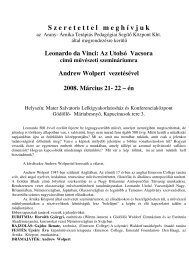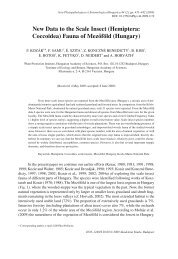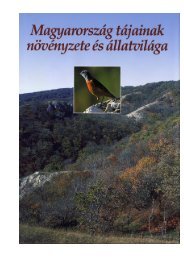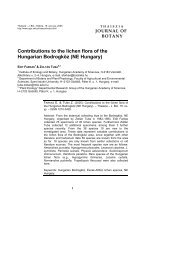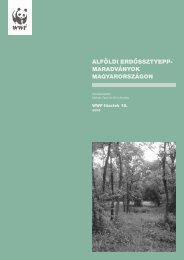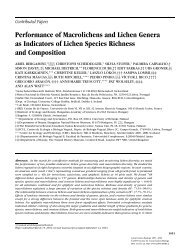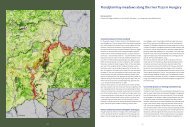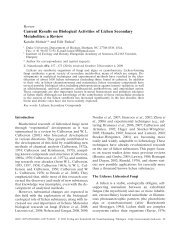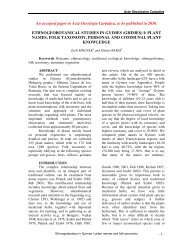PhotoprotectionLichens use a number <strong>of</strong> strategies to protect the light-sensitive algal symbionts against highlevels <strong>of</strong> light and the damaging effects <strong>of</strong> UV radiation, e.g., light screening and UV-Bprotection by <strong>lichen</strong> compounds. The light-screening theory was formulated by ERTL (1951),who found that cortical <strong>lichen</strong> compounds increase the opacity <strong>of</strong> the upper cortex, and thusdecrease high incident irradiance reaching the algal layer. Light screening cortical pigments(such as parietin, usnic acid, vulpinic acid) regulate solar irradiance reaching the algal layer(GALLOWAY 1993, SOLHAUG and GAUSLAA 1996, see also FARKAS 2007) by absorbing much<strong>of</strong> the incident light and thus protecting the photosynthetic partner against intense radiation(RAO and LEBLANC 1965) (Figure 4). UV-B inhibits photosynthesis and damages DNA.Several <strong>lichen</strong> <strong>secondary</strong> <strong>metabolites</strong> (including atranorin, calycin, pinastric acid, rhizocarpicacid, usnic acid, vulpinic acid) have strong UV absorption abilities and might function asfilters for excessive UV-B irradiation (RUNDEL 1978, SOLHAUG and GAUSLAA 1996).Figure 4. The anthraquinone parietin is an orange cortical pigment and widespread inTeloschistaceae, thus also occurs in Xanthoria parietina. Parietin protects thephotosynthetic apparatus <strong>of</strong> the photobiont against intense radiation.AllelopathyLichen <strong>secondary</strong> <strong>metabolites</strong> can function as allelopathic agents, i.e., they may affect thedevelopment and growth <strong>of</strong> neighboring <strong>lichen</strong>s, fungi, mosses and vascular plants, as well asmicroorganisms (LAWREY 1995, MACÍAS et al. 2007, ROMAGNI et al. 2004, RUNDEL 1978).Competition occurs between <strong>lichen</strong> thalli for space and light on a variety <strong>of</strong> substrates, andplays important roles in determining the structure <strong>of</strong> <strong>lichen</strong> communities and the distribution<strong>of</strong> individual species (ARMSTRONG and WELCH 2007). Lichen <strong>secondary</strong> chemistry mightplay a role in this competition (ARMSTRONG and WELCH 2007).Antimicrobial activityAtranorin, fumarprotocetraric acid, gyrophoric acid, lecanoric acid, physodic acidprotocetraric acid, stictic acid and usnic acid showed relatively strong antimicrobial effectsagainst six bacteria and ten fungi, among which were human, animal and plant pathogens,mycotoxin-producers and food-spoilage organisms (RANKOVIĆ and MIŠIĆ 2008). Since
microorganisms have developed resistance to many antibiotics, pharmacologists need topursue new sources for antimicrobial agents. All these results suggest that <strong>lichen</strong>s and their<strong>metabolites</strong> yield significant new bioactive substances for the treatment <strong>of</strong> various diseasescaused by microorganisms.Antiherbivore activityLichens are grazed by herbivores, e.g., insects, mites, snails, slugs. However, herbivory on<strong>lichen</strong>s seems to be rare, presumably due to their low nutritional quality, specific structuralfeatures and the production <strong>of</strong> defense compounds (NIMIS and SKERT 2006, PÖYKKÖ et al.2005). It is known that natural plant-derived products have a less detrimental impact on theenvironment than synthetic chemicals, and thus <strong>lichen</strong> substances could be good candidatesfor new pesticides (DAYAN and ROMAGNI 2001).Cytotoxic, antitumor, and antiviral activityMany <strong>lichen</strong> <strong>secondary</strong> <strong>metabolites</strong> exhibit cytotoxic and antiviral properties and could bepotential sources <strong>of</strong> pharmaceutically useful chemicals.Human Papilloma Virus can cause cervical cancer. Due to clinical experiments, the adjuvanttreatment with usnic acid and zinc sulphate after radiosurgery promotes reepithelization andreduces recurrence (SCIRPA et al. 1999). Usnic acid decreases proliferation <strong>of</strong> human breastcancer cells and human lung cancer cells without any DNA damage (MAYER et al. 2005),accordingly, it may represent a novel source for a natural non-genotoxic anticancer drug(chemotherapeutic agent).Allergy to <strong>lichen</strong> substancesLichen substances can be contact allergens (e.g., atranorin, lobaric acid, stictic acid). Theycan cause occupational allergic contact dermatitis in forestry and horticultural workers(“woodcutter’s eczema”), as well as cause non-occupational allergic dermatitis during allkinds <strong>of</strong> outdoor <strong>activities</strong>, such as cutting firewood, hunting, and using cosmetics (perfumes,after-shave lotions, sunscreen products) that contain <strong>lichen</strong> <strong>metabolites</strong> (AALTO-KORTE et al.2005). Various skin and respiratory symptoms have been observed, such as erythema, itching,scaling, contact urticaria, rhinitis, and asthma (AALTO-KORTE et al. 2005, MITCHELL andCHAMPION 1965).Candidates for antipyretic and analgesic drugsSome <strong>lichen</strong> substances have been shown to relieve pain effectively or reduce fever andinflammation in various mammals, and it is reasonable to assume that these compounds alsocould be effective in humans. VIJAYAKUMAR et al. (2000) reported that usnic acid, isolatedfrom Roccella montagnei, showed significant anti-inflammatory activity in rats. Diffractaicand usnic acids have an analgesic effect in mice in vitro (OKUYAMA et al. 1995), and usnicacid also is an antipyretic.ConclusionsMore than 1000 <strong>secondary</strong> products have been identified to date in <strong>lichen</strong>s, and newcompounds will certainly be found from poorly studied or newly discovered <strong>lichen</strong>s,especially from the under-collected tropics. Furthermore, development in analitical



